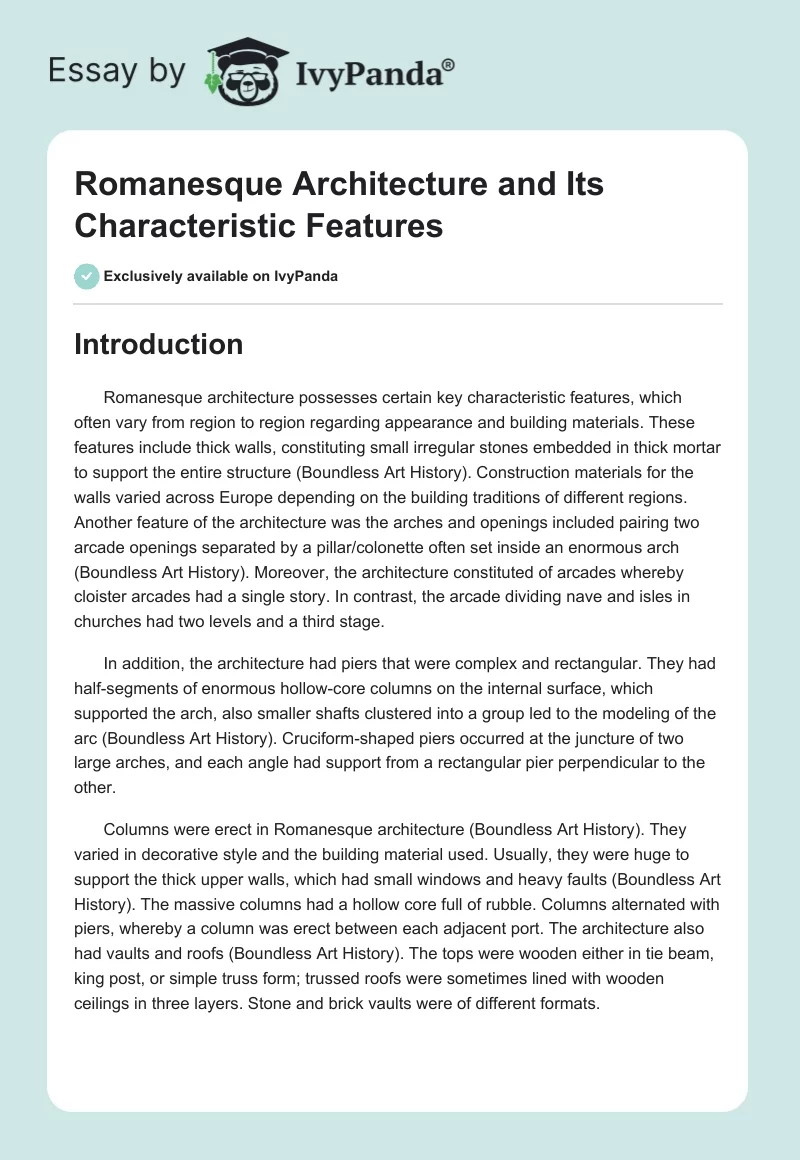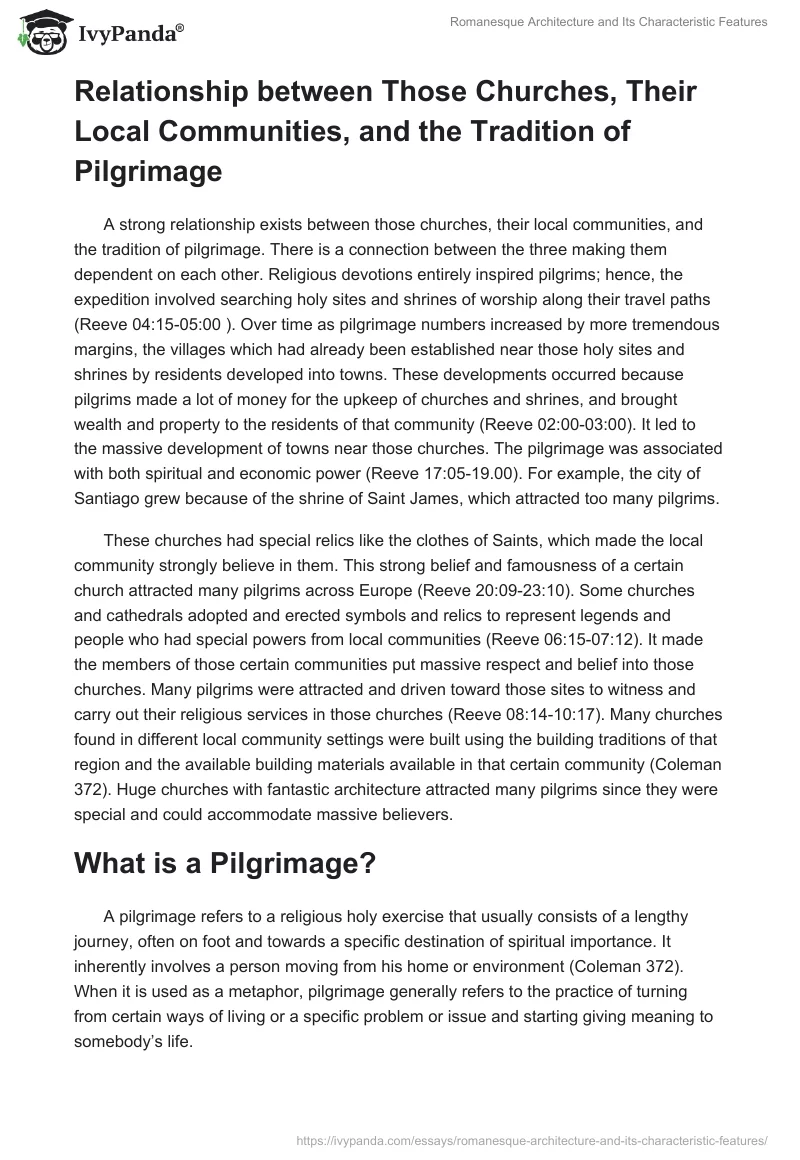Introduction
Romanesque architecture possesses certain key characteristic features, which often vary from region to region regarding appearance and building materials. These features include thick walls, constituting small irregular stones embedded in thick mortar to support the entire structure (Boundless Art History). Construction materials for the walls varied across Europe depending on the building traditions of different regions. Another feature of the architecture was the arches and openings included pairing two arcade openings separated by a pillar/colonette often set inside an enormous arch (Boundless Art History). Moreover, the architecture constituted of arcades whereby cloister arcades had a single story. In contrast, the arcade dividing nave and isles in churches had two levels and a third stage.
In addition, the architecture had piers that were complex and rectangular. They had half-segments of enormous hollow-core columns on the internal surface, which supported the arch, also smaller shafts clustered into a group led to the modeling of the arc (Boundless Art History). Cruciform-shaped piers occurred at the juncture of two large arches, and each angle had support from a rectangular pier perpendicular to the other.
Columns were erect in Romanesque architecture (Boundless Art History). They varied in decorative style and the building material used. Usually, they were huge to support the thick upper walls, which had small windows and heavy faults (Boundless Art History). The massive columns had a hollow core full of rubble. Columns alternated with piers, whereby a column was erect between each adjacent port. The architecture also had vaults and roofs (Boundless Art History). The tops were wooden either in tie beam, king post, or simple truss form; trussed roofs were sometimes lined with wooden ceilings in three layers. Stone and brick vaults were of different formats.
Relationship between Those Churches, Their Local Communities, and the Tradition of Pilgrimage
A strong relationship exists between those churches, their local communities, and the tradition of pilgrimage. There is a connection between the three making them dependent on each other. Religious devotions entirely inspired pilgrims; hence, the expedition involved searching holy sites and shrines of worship along their travel paths (Reeve 04:15-05:00 ). Over time as pilgrimage numbers increased by more tremendous margins, the villages which had already been established near those holy sites and shrines by residents developed into towns. These developments occurred because pilgrims made a lot of money for the upkeep of churches and shrines, and brought wealth and property to the residents of that community (Reeve 02:00-03:00). It led to the massive development of towns near those churches. The pilgrimage was associated with both spiritual and economic power (Reeve 17:05-19.00). For example, the city of Santiago grew because of the shrine of Saint James, which attracted too many pilgrims.
These churches had special relics like the clothes of Saints, which made the local community strongly believe in them. This strong belief and famousness of a certain church attracted many pilgrims across Europe (Reeve 20:09-23:10). Some churches and cathedrals adopted and erected symbols and relics to represent legends and people who had special powers from local communities (Reeve 06:15-07:12). It made the members of those certain communities put massive respect and belief into those churches. Many pilgrims were attracted and driven toward those sites to witness and carry out their religious services in those churches (Reeve 08:14-10:17). Many churches found in different local community settings were built using the building traditions of that region and the available building materials available in that certain community (Coleman 372). Huge churches with fantastic architecture attracted many pilgrims since they were special and could accommodate massive believers.
What is a Pilgrimage?
A pilgrimage refers to a religious holy exercise that usually consists of a lengthy journey, often on foot and towards a specific destination of spiritual importance. It inherently involves a person moving from his home or environment (Coleman 372). When it is used as a metaphor, pilgrimage generally refers to the practice of turning from certain ways of living or a specific problem or issue and starting giving meaning to somebody’s life.
My Pilgrimage
While in secondary school, I read a book about the scientific origin of life and the evolution of humankind. The book explained how life came to be and how human beings evolved through various stages up to the current creatures they are. It confused me a lot since I believed God was the Creator. I did further research on scientific materials, which made me completely forget about the existence of God. I transitioned from theism to atheism. I could no longer go to church or attend religious meetings in school. I lost friends both at school and at home. That made me quit going to school and I could stay the whole day locked up in my room. My parents intervened and presented me to the spiritual leaders of the local church I used to attend. The leaders could talk to me and helped me read the Bible along with them daily. They brought out the bigger picture and openness to me out God, which I had forgotten and had not even realized. It made me return my absolute commitment to the belief and service of God. It was a challenging process.
References
“Boundless Art History.” Lumen Learning, 2019. Web.
Coleman, Simon. “Pilgrimage.”The Wiley Blackwell Companion to the Study of Religion (2021): 371-381. Web.
Reeve, Simon. “Pilgrimage: The Road to Rome_ Pilgrimage with Simon Reeve _Timeline.”YouTube, 2018. Web.


